Case 3
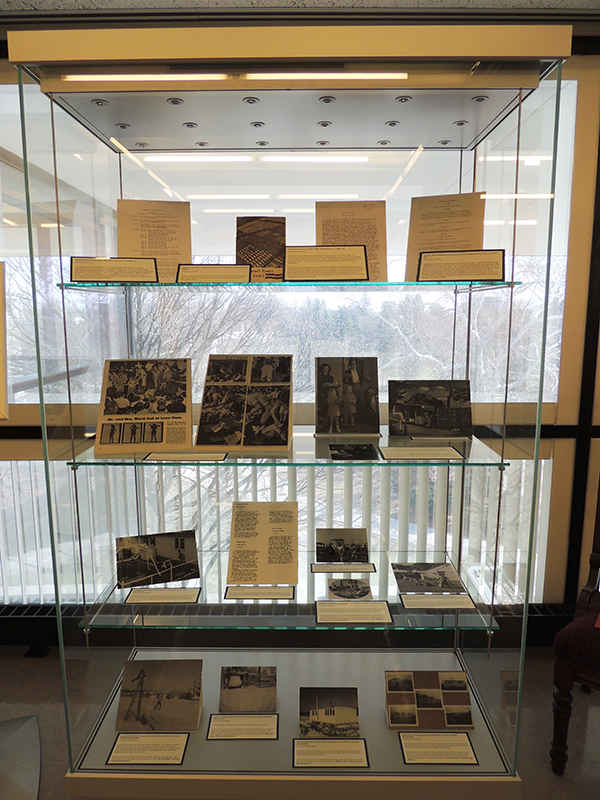
Building a Community
For residents, Pammel Court was more than just a location for temporary housing units, it was a community built on shared experiences, cooperation, and civic duty. Created to provide student housing for married veterans and their families, Pammel Court’s early residents were connected by threads of education, military service, and family life. The fact that Pammel’s residents juggled roles of student, spouse and parent meant that they had responsibilities beyond the norms of typical Iowa State life. Pammel Court was home to a new, non-traditional student. Where young unmarried students attended sorority parties or school dances, Pammel’s married students founded a cooperative grocery store, lobbied the school for paved streets, and started a daycare. To ensure that Pammel Court could be its own community, residents formed a local government consisting of a mayor and council. Pammel Court’s government would continue even after the veteran status requirement for residency ended in the early 1960s.
The shared experiences of residents also affected social life within Pammel Court. For married students with tight budgets, entertainment and other activities were often improvised within limited means. Weekend festivals, potluck dinners, and parties after the kids were asleep were common throughout Pammel Court’s history.
Images in the case:
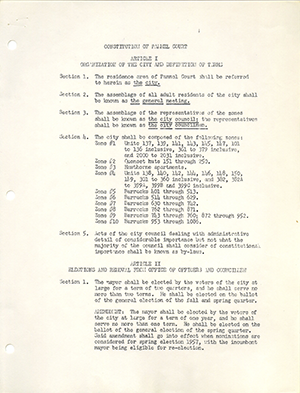
Pammel Court Constitution, 1957. (RS 7/4/12, box 11, folder 11). Julian C. Schilletter Papers.
The Pammel Court Constitution was the principal document concerning community life for the married student housing units. The Constitution was periodically updated, or even re-written, to reflect the changing needs of Pammel residents. This version from 1957 is of special note because it refers to Pammel Court as “the city” in Section 1. Although Pammel Court was not an actual incorporated city, the wording illustrates how residents viewed themselves as a community with its own government.
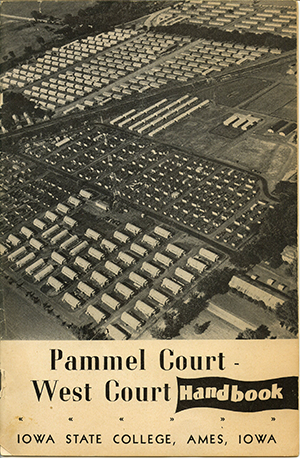
Pammel Court West Handbook, undated. (RS 7/4/3, box 3, “Pammel Court" folder”). Department of Residence Buildings Records.
These handbooks provided new residents of Pammel Court with important information concerning trash pickup and removal, pet policies, and other community policies.
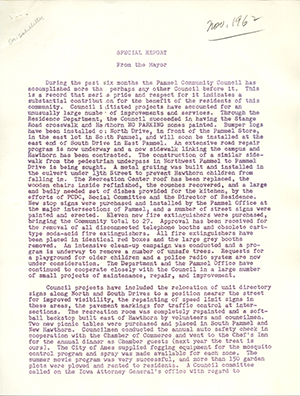
Special Report from Mayor, 1962. (RS 7/4/12, box 11, folder 14). Julian C. Schilletter Papers.
Pammel Court residents elected their first mayor and council in 1946. As Pammel’s community leader, the mayor would write an annual report detailing the activities of the administration. These reports often included information on sanitation issues, safety concerns, street paving projects, and community amenities.
These reports also highlight how politically engaged Pammel residents were in building their community. At various times in Pammel Court’s history, the mayor and council would lobby Iowa State’s administration for improvements, such as with better insulation in the units or erecting a fence alongside the railroad tracks. Note that in 1962, Pammel’s elected government referred to itself as the “Pammel Community Council.”
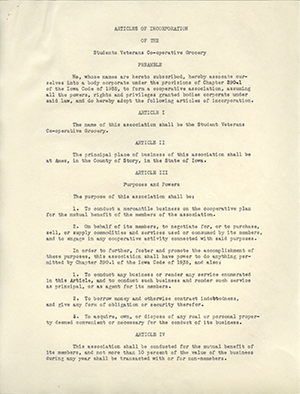
Articles of Incorporation for Pammel Grocery, 1946. (RS 7/3/11, box 51, folder 26). Maurice D. Helser Papers.
The Pammel Court Cooperative Grocery opened in 1946. Known as the “co-op,” the grocery was operated by veterans and their families and was originally open only to Pammel Court residents. The co-op received national attention nearly as soon as it opened, as colleges and veteran-student organizations sought to open their own cooperative groceries. According to an article in the Iowa State Student, the Pammel co-op received inquiries from the University of Tennessee, the University of Arizona, and the University of Iowa, among others (Iowa State Student, 20 August 1946).
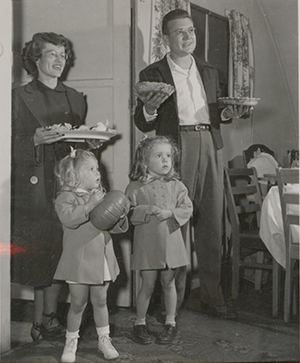
Harry and Elizabeth Tullis and Two Children on Thanksgiving Day, 1948. (RS 7/4/H, box 473). University Photographs.
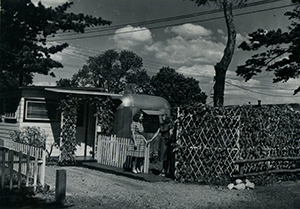
Two Women Outside Trailer, undated. (RS 7/4/I, box 489). University Photographs.
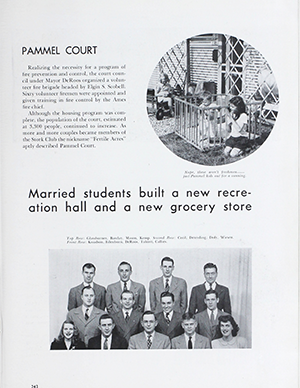
The Bomb, 1948, page 243 (LD2548 lo9b). Article available online, in Special Collections and University Archives, and in Parks Library General Collection.
This image from the 1948 edition of the Iowa State student yearbook, the Bomb, shows three children playing outside of a Pammel Court Unit. The yearbook caption to the photograph referred to Pammel Court as “Fertile Acres.”
One former Pammel Court family, speaking of the number of children in the housing development, stated that “Pammel Court was the incubator that built the McFarland Clinic. All those babies and mothers turned the OB/GYN and pediatrics departments into goldmines for Ernie McFarland.” (Department of Buildings' Records, RS 7/4/3, box 3, “Pammel Court Reminiscences”)
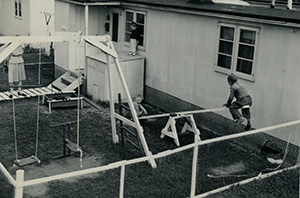
Children on Play Equipment, undated. (RS 7/4/I, box 489). University Photographs.
Children at play was a common sight within Pammel Court. Although the Pammel units were in close proximity to one another, there was a small yard space for each unit. At some units, the yards were enclosed with chicken wire fencing to provide children with a safe play area. Note the young child standing atop the storage shed.
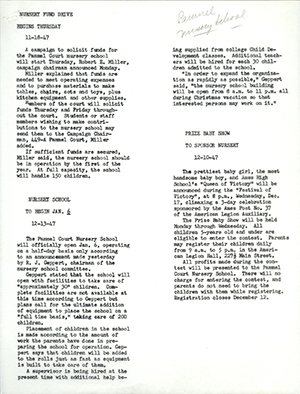
Pammel Nursery Newsletter, 1947. (RS 7/4/12, box 11, folder 16). Julian C. Schilletter Papers.
The Pammel Court Nursery School opened with “approximately 30” children in 1947 with plans to eventually expand enrollment to 200. A child’s enrollment in the school was dependent upon how much work parents performed in building the nursery.
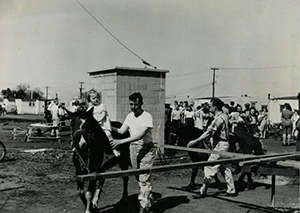
May Daze Pony Ride, 1947. (RS 7/4/I, box 489). University Photographs.
In 1947, Pammel Court families organized a May celebration that featured activities such as the pony ride illustrated in the photograph.
Video of May Daze parade, circa 1940s.
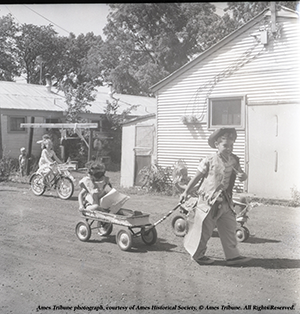
Pammel Court 4th of July, 1957. Facsimile Reproduction. Ames Tribune photograph, courtesy of Ames Historical Society, © Ames Tribune. All Rights Reserved.
Just as their parents often had to improvise to make the most ... quarters, the children of Pammel Court were resourceful in ... . This image shows a group of children organizing there own ... down the street of Pammel Court.
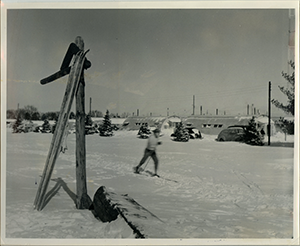
Snow Scene with Cross Country Skier, undated. (RS 7/4/I, box 489). University Photographs.
In addition to school work and family life, the weather was a major concern of Pammel Court residents. As surplus military housing, many of the units on Pammel did not have proper insulation for the winter months. Throughout the late 1940s and 1950s, Pammel residents would lobby Iowa State officials to provide better insulation for the units.
One former resident of Pammel Court in the mid-1950s recalled that their “fuel bill for the housing unit was more than we paid in rent.” (Department of Buildings' Records, RS 7/4/3, box 3, “Pammel Court Reminscenses”).
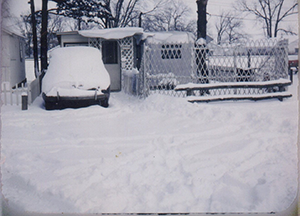
Trailer in the Snow, 1946. (RS 7/4/3, box 3, “Pammel Court" folder). University Photographs.
In the late 1940s, Pammel Court’s trailer units did not have sewer access.
In 2007, one former Pammel resident recalled that toilet facilities were located in Quonset Huts alongside laundry facilities. “It was quite an adventure to hike there in deep snow, especially when competing with others struggling toward the same objective. We kept a chamber pot in our unit for emergencies.” (Department of Buildings' Records, RS 7/4/3, box 3, "Pammel Court" folder).
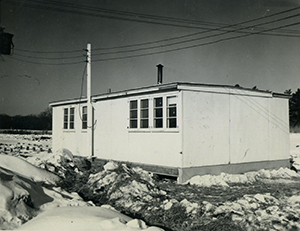
Pammel Court Unit in Winter, undated. (RS 7/4/I, box 489). University Photographs.
In addition to poor insulation, another problem in keeping the units warm was that the houses either sat directly on a concrete slab or were on a foundation several inches from ground level.
“The emergency door in the bedroom would frequently have frost on the inside,” one Pammel resident remembered years later. (Department of Buildings' Records, RS 7/4/3, box 3, “Pammel Court Reminscenses”).
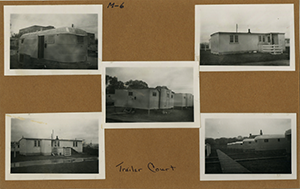
Trailer Court Collage, undated. (RS 7/4/I, box 489). University Photographs.
While Pammel Court’s units could be unbearably cold in the winter, they could also be insufferably hot in the summer months. The Quonset Huts and barracks were especially hot due to the corrugated metal siding.
One Pammel Court resident, recalling a particularly hot summer spent with a newborn, said that his family “would escape the heat [of our unit] and drive around Ames in our car with all the windows down till the sun set and the temperature began to moderate in our home.” (Department of Buildings' Records, RS 7/4/3, box 3, "Pammel Court" folder).